Howard Greenfield
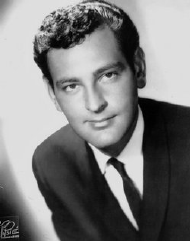
Howard Greenfield was an American lyricist and songwriter, who
for several years in the 1960s worked out of the famous Brill
Building. He is best known for his successful songwriting
collaborations, including one with Neil Sedaka from the late
1950s to the mid-1970s, and a near-simultaneous (and equally
successful) songwriting partnership with Jack Keller throughout
most of the 1960s.
Howard Greenfield was born March 15, 1936 and lived in the
same six-story brick apartment building as Neil Sedaka at 3260
Coney Island Avenue in Brighton Beach.
On November 11, 1952, at the urging of mother Ella, Greenfield
rang Sedaka's doorbell. It was then he proposed that Sedaka
compose music to a set of lyrics he had written. Sedaka composed
his first melody, My Life's Devotion, set to
Greenfield's lyrics. Soon they were writing a song a day.
Greenfield idolized Lorenz Hart, Richard Roger's lyricist.
Hart was a homosexual, just as Greenfield in his teens may not
yet have recognized yet that he too was gay.
In 1954, while at Andria's Pizzeria with Sedaka, Earth
Angel was playing on the jukebox. Quite different than
the classical, Broadway musicals and Tin Pan Alley tunes Sedaka
was comfortable with, Earth Angel excited him. Greenfield
dismissed it as disgusting and off key. Sedaka persisted and the
two wrote Mr. Moon. Sedaka performed with a saxophone
player and drummer at his Abraham Lincoln High School assembly.
When the students heard they it all got up a danced. The uproar
so disturbed the school's principal that Sedaka was ordered not
to play it at the second assembly.
While doing clerical work at Famous Music, Greenfield
befriended a songwriting secretary at the Brill Building. A
recommendation from her led to Greenfield and Sedaka to Atlantic
Records where Jerry Wexler bought several of their songs for the
Cookies.
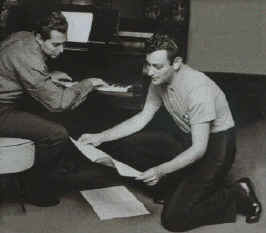
L to R - Neil Sedaka and Howard Greenfield
Their first recorded compositions took up both sides of the
1956 non-charting debut single by the Tokens, of which Sedaka
(but not Greenfield) was briefly a member. They then went on to
supply the song "Passing Time" to the Cookies, as well
as other non-hit singles to doo-wop and groups the Clovers and
the Cardinals. At this point, though their songs were being
recorded, the income derived from these songs was minimal, and
Greenfield worked as a messenger for National Cash Register.
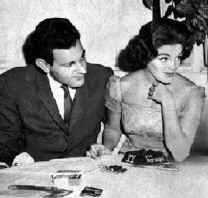
With Connie Francis
|
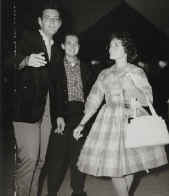
With Neil Sedaka and Connie
Francis
Photo Courtesy Neil
Sedaka
|
In the spring of 1958, Greenfield and Sedaka signed to Al
Nevins and Don Kirshner's Aldon Music as songwriters, which had
offices at 1650 Broadway in New York. (The company later moved to
the Brill Building.) In their first year there, Greenfield and
Sedaka wrote material for Jimmy Clanton and Bobby Darin, and
scored their first major pop hit single with Connie Francis'
"Stupid Cupid", which hit #14 on the US pop charts in
September 1958. They would also write Francis' later hits
"Fallin'", "Frankie" and the "Theme to
Where the Boys Are," the film in which she starred.
In 1958, Sedaka signed to RCA Records as a solo artist, he and
Greenfield composed a string of hits for Sedaka to record –
among them "The Diary", "Oh! Carol",
"Stairway to Heaven", "Calendar Girl",
"Little Devil", "Happy Birthday Sweet
Sixteen", "Next Door to an Angel" and the
chart-topping "Breaking Up Is Hard to Do". Sedaka's
recordings eventually sold a combined 25 million records.
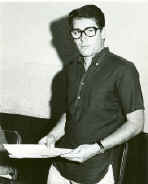
Jack Keller
As Sedaka's promotional and touring commitments began taking
up more and more of his time, Kirshner encouraged Greenfield to
collaborate with other Aldon writers. Beginning in 1960,
Greenfield began a regular collaboration with Jack Keller; they
would write songs together every Monday and Wednesday for six
straight years. Successful Greenfield/Keller collaborations
included two consecutive US #1 hits for Connie Francis,
"Everybody's Somebody's Fool" and "My Heart Has a
Mind of Its Own". They also wrote another Francis top 10
hit, "Breakin' in a Brand New Broken Heart", Jimmy
Clanton's top 10 hit "Venus in Blue Jeans", as well as
songs recorded by Frank Sinatra, Ernest Tubb, Patti Page and
Brenda Lee. In addition, Greenfield and Keller supplied the theme
music for U.S. television programs such as Gidget, Bewitched and
The Flying Nun.
Greenfield's one and only collaboration with Aldon songwriter
Carole King resulted in "Crying in the Rain", a top ten
hit for the Everly Brothers in 1962. The collaboration came about
when, on a whim, two Aldon songwriting partnerships decided to
switch partners for a day with Gerry Goffin (who normally worked
with King) partnered with Jack Keller, leaving King and
Greenfield to work as a pair for the day. Despite the commercial
success of their collaboration, King and
Greenfield never wrote another song together.
In 1962, Greenfield found a partner to share his life with,
cabaret singer Tory Damon. Together they moved into an apartment
on East 63rd Street in Manhattan before moving to Los Angeles in
1966. Greenfield still continued to write with Sedaka and
Keller, both of whom moved to California within a year or two of
Greenfield.
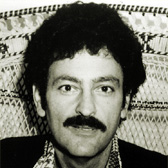
Sedaka and Greenfield also continued to work together as
Sedaka's schedule allowed. After Sedaka's singing career cooled
in 1963, they kept writing hits for other artists, including the
5th Dimension's and Tom Jones' "Puppet Man".
Greenfield also collaborated with other Aldon songwriters,
including Helen Miller, with whom he co-wrote "Foolish
Little Girl" (the Shirelles' final Top Ten hit), "It
Hurts to Be in Love", originally intended for Neil Sedaka
but ultimately recorded by Gene Pitney, as well as a new theme
for the TV series Hazel for its fourth season. He also
collaborated with Bill Buchanan recording a novelty record called
"The Invasion" as Buchanan and Greenfield in 1964.
Sedaka began working with other lyricists in 1970, though he
and Greenfield still occasionally worked together after this
time; Sedaka and Greenfield ended their songwriting partnership
in 1973. Their last collaboration, appropriately named "Our
Last Song Together," would be a minor hit for Bo Donaldson
and The Heywoods. In 1975, their song "Love Will Keep Us
Together" (originally recorded by Sedaka in 1973) topped the
Billboard Hot 100 chart in a cover version by Captain &
Tennille, as well as earning a Grammy Award for Record of the
Year. This version of "Love Will Keep Us Together" was
the best-selling single of the year.
Greenfield co-wrote four songs that reached #1 on the US
Billboard charts: "Breaking Up Is Hard to Do", as
recorded by Sedaka; "Everybody's Somebody's Fool" and
"Breakin' in a Brand New Broken Heart", both as
recorded by Connie Francis, and "Love Will Keep Us
Together", as recorded by Captain & Tennille. He also
co-wrote numerous other top 10 hits for Sedaka (including
"Oh! Carol", "Stairway to Heaven",
"Calendar Girl", "Little Devil", "Happy
Birthday Sweet Sixteen", and "Next Door to an
Angel"); Francis (including the "Theme to Where The
Boys Are" and "My Heart Has a Mind of Its Own");
the Everly Brothers ("Crying in the Rain"); Jimmy
Clanton ("Venus in Blue Jeans") and the Shirelles
("Foolish Little Girl"). Greenfield also co-wrote the
theme songs to numerous 1960s TV series, including Gidget,
Bewitched, The Flying Nun and Hazel.
In 2005, "Is This The Way To Amarillo", a song
Greenfield had written with Sedaka in the early 1970s, reached #1
on the UK charts in the original 1971 version by Tony Christie.
The video featured an all-star celebrity line-up lip-synching the
track, and the proceeds went to charity. The record stayed at #1
for 7 weeks, and became the UK's best-selling record of the
millennium to that time.
Greenfield died in Los Angeles in 1986 from complications from
AIDS, eleven days before his 50th birthday. He was interred at
Forest Lawn Memorial Park. Damon died from AIDS complications
just a few days later and is buried next to Greenfield
In 1991, Greenfield was inducted into the Songwriters Hall of
Fame.






